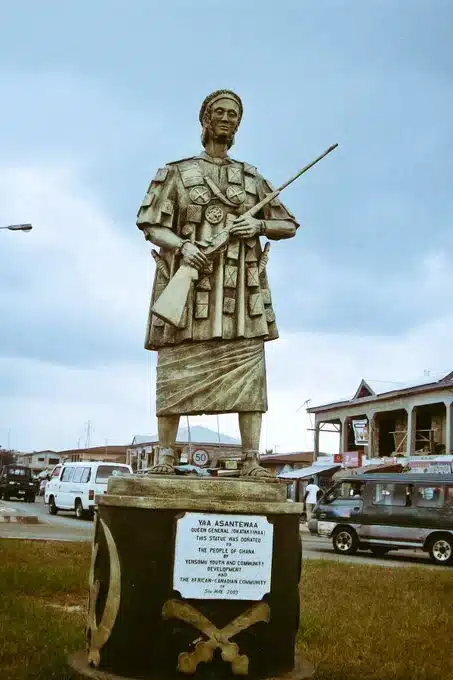Yaa Asantewaa, born on October 17, 1840, in Besease, was the Queen Mother of Ejisu in the Ashanti Empire, which is now part of modern-day Ghana. She held this esteemed position as she was appointed by her brother, Nana Akwasi Afrane Opese, who was the ruler of Edweso, or the Edwesuhene. However, Yaa Asantewaa’s significance extends far beyond her royal lineage. In 1900, she led the Ashanti war, known as the War of the Golden Stool or the Yaa Asantewaa War of Independence, against the British Empire, leaving an indelible mark on history.
Yaa Asantewaa’s early life was uneventful. She was the daughter of Kwaku Ampoma and Ata Po, and her brother, Afrane Panin, became the chief of Edweso. Yaa Asantewaa cultivated crops in the vicinity of Boankra, leading a simple yet purposeful life. Eventually, she entered into a polygamous marriage and became a mother to a daughter.

Yaa Asantewaa’s life took a dramatic turn when her brother, the ruler of Edweso, passed away in 1894. As the Queen Mother, she utilized her authority to nominate her own grandson as Ejisuhene. However, the British exiled him to the Seychelles in 1896, along with the King of Asante Prempeh I and other Asante government members. This event led Yaa Asantewaa to become the regent of the Ejisu-Juaben district.
During this period, the British governor-general of the Gold Coast, Frederick Hodgson, demanded the Golden Stool, which symbolized the sovereignty of the Asante nation. This request sparked a secret meeting among the remaining members of the Asante government in Kumasi to strategize the return of their king. At this crucial gathering, Yaa Asantewaa stood before the council and delivered a resolute speech:
“How can a proud and brave people like the Asante sit back and look while white men took away their king and chiefs, and humiliated them with a demand for the Golden Stool? The Golden Stool only means money to the whitemen; they have searched and dug everywhere for it. I shall not pay one predwan to the governor. If you, the chiefs of Asante, are going to behave like cowards and not fight, you should exchange your loincloths for my undergarments.”
To emphasize her determination to wage war, she grabbed a gun and fired a shot in front of the council members.
Yaa Asantewaa’s courage and leadership qualities led to her selection as the war leader of the Asante fighting force, making her the first and only woman in Asante history to hold such a position. She commanded an army of 5,000 soldiers in the Ashanti-British War of the Golden Stool, also known as the Yaa Asantewaa War.
The rebellion began in March 1900, with the Ashanti forces besieging the fort at Kumasi, where the British had sought refuge. After several months, the Gold Coast governor dispatched a force of 1,400 soldiers to quell the rebellion. During the conflict, Queen Yaa Asantewaa and fifteen of her closest advisers were captured. They, too, were exiled to the Seychelles.

The rebellion marked the culmination of the Anglo-Asante series of wars that had persisted throughout the 19th century. On January 1, 1902, the British officially annexed the territory previously controlled by the Asante Empire, transforming it into a protectorate under the British crown.
Yaa Asantewaa passed away in exile on October 17, 1921, in the Seychelles. Three years after her death, on December 17, 1924, King Prempeh I and the remaining members of the exiled Asante court were allowed to return to Asante. King Prempeh I ensured that Nana Asantewaa’s remains and those of other exiled Asantes were brought back for a proper royal burial.
Yaa Asantewaa’s dream of an independent Asante, free from colonial rule, was eventually realized on March 6, 1957, when the Asante protectorate gained independence as part of Ghana. Ghana became the first African nation in West Africa to achieve this remarkable feat.
Yaa Asantewaa’s role in challenging British colonialism has made her a beloved figure in Asante history and the history of Ghana as a whole. Her unwavering commitment to defending her kingdom and her influential leadership as a queen mother continue to inspire generations. In recognition of her significant contributions, the Yaa Asantewaa Girls’ Secondary School was established in Kumasi in 1960. Additionally, a week-long centenary celebration was held in Ghana in 2000, during which a museum dedicated to her was inaugurated in Kwaso, Ejisu-Juaben District. Despite a devastating fire in 2004 that destroyed historical artifacts, efforts to honor her legacy persist, with calls for the construction of a new Yaa Asantewaa Museum.
Yaa Asantewaa’s story endures, reminding us of the power of resilience, determination, and female leadership. Her name lives on in songs, cultural celebrations, and various artistic works, ensuring that her heroic spirit remains a beacon of inspiration for generations to come.






































